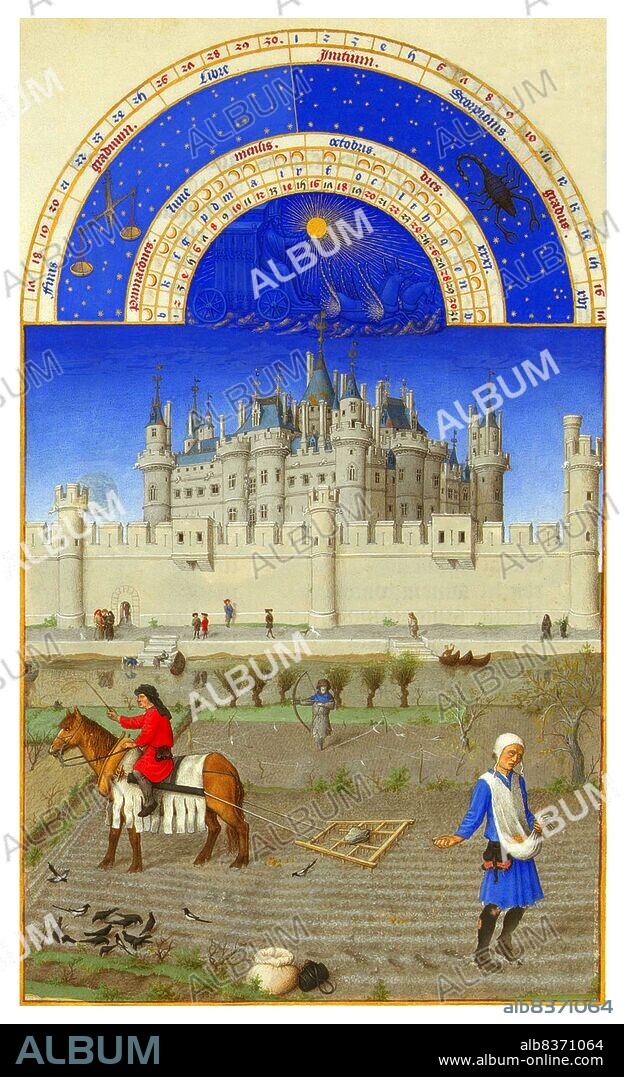alb8371064
France: Sowing winter grain by the Louvre Palace, October in the calendar section of the Tres Riches Heures du Duc de Berry< / i>, tempera on vellum, Limbourg Brothers, c. 1415 CE

|
Add to another lightbox |
|
Add to another lightbox |



Title:
France: Sowing winter grain by the Louvre Palace, October in the calendar section of the Tres Riches Heures du Duc de Berry< / i>, tempera on vellum, Limbourg Brothers, c. 1415 CE
Caption:
The Tres Riches Heures du Duc de Berry is the most famous and possibly the best surviving example of French Gothic manuscript illumination, showing the late International Gothic phase of the style. It is a book of hours: a collection of prayers to be said at the canonical hours.
. It was created between c. 1412 and 1416 for the extravagant royal bibliophile and patron John, Duke of Berry, by the Limbourg brothers. When the three painters and their sponsor died in 1416, possibly victims of plague, the manuscript was left unfinished. It was further embellished in the 1440s by an anonymous painter, who many art historians believe was Barthelemy d'Eyck. In 1485-1489, it was brought to its present state by the painter Jean Colombe on behalf of the Duke of Savoy.
. Acquired by the Duc d'Aumale in 1856, the book is now in the Musee Conde, Chantilly, France.
. It was created between c. 1412 and 1416 for the extravagant royal bibliophile and patron John, Duke of Berry, by the Limbourg brothers. When the three painters and their sponsor died in 1416, possibly victims of plague, the manuscript was left unfinished. It was further embellished in the 1440s by an anonymous painter, who many art historians believe was Barthelemy d'Eyck. In 1485-1489, it was brought to its present state by the painter Jean Colombe on behalf of the Duke of Savoy.
. Acquired by the Duc d'Aumale in 1856, the book is now in the Musee Conde, Chantilly, France.
Credit:
Album / Universal Images Group / Pictures From History
Releases:
Model: No - Property: No
Rights questions?
Rights questions?
Image size:
3108 x 5100 px | 45.3 MB
Print size:
26.3 x 43.2 cm | 10.4 x 17.0 in (300 dpi)
Keywords:
1415 CE • ART • ARTS • BERRY, JEAN, DUC DE • BOOK OF HOURS • BOOK OF PRAYERS • CALENDAR • DUC DE BERRY • DUC DE BERRY, JEAN • DUKE: JEAN DE BERRY, FRANCE • FRANCE • FRENCH • GOTHIC ART • GOTHIC • LEGEND • LIMBOURG BROTHERS • LIMBOURG • LIVRE D'HEURES, DUC BERRY • LOUVRE PALACE • MANUSCRIPT • OCTOBER • PAINT • PAINTING • PRAYER BOOK DUC DE BERRY • TIME • TRES RICHES HEURES DU DUC DE BERRY • TRES RICHES HEURES • VELLUM
 Pinterest
Pinterest Twitter
Twitter Facebook
Facebook Copy link
Copy link Email
Email

